Discover the Spiritual Splendor of Ganden Monastery in Tibet
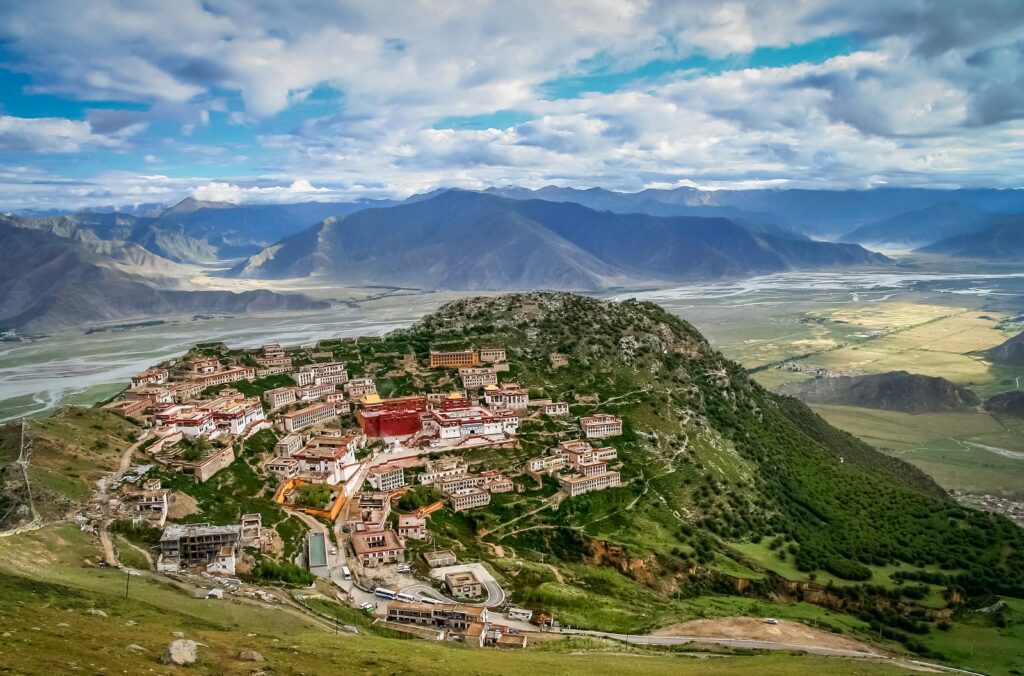
An Essential Guide to Visiting Ganden Monastery
Nestled high in the mountains of Tibet, Ganden Monastery stands as a beacon of spiritual devotion and architectural splendor. Founded in 1409 by the revered Je Tsongkhapa, the monastery is one of the Great Three Monasteries of the Gelug School of Tibetan Buddhism and holds profound historical significance. Perched at an elevation of 4,300 meters, it offers breathtaking views of the surrounding valleys and peaks, making it not only a pilgrimage site but also a paradise for nature lovers and trekkers alike.
As you approach Ganden, you’ll be captivated by its unique blend of serene spirituality and stunning landscapes. The monastery, with its intricate chapels and gilded statues, invites visitors to explore its rich history and vibrant religious practices. Whether you’re taking part in the sacred Ganden Kora, a pilgrimage route that encircles the monastery, or witnessing the mesmerizing Thangka Festival, you’ll find that Ganden Monastery is a place where faith and beauty intertwine.
This essential guide will help you navigate the spiritual and scenic wonders of Ganden Monastery, providing insights into its storied past, unique architecture, and the best experiences to enhance your visit. Prepare to embark on a journey that transcends the ordinary, where every step is steeped in tradition and every moment is filled with awe.
In This Guide
- An Essential Guide to Visiting Ganden Monastery
- The Rich History and Legends of Ganden Monastery
- Main Highlights: What You Absolutely Can’t Miss
- Planning Your Visit: A Practical Guide
- Tickets: Prices, Booking, and Tips
- How to Get There: A Complete Transportation Guide
- Local Cuisine and Accommodation Nearby
- Frequently Asked Questions
- Final Thoughts on Your Trip
The Rich History and Legends of Ganden Monastery
Nestled atop the picturesque Wangbori Mountain, Ganden Monastery, known as Ganden Namgyal Ling, stands as a beacon of Tibetan Buddhism and a testament to the spiritual legacy of its founder, Je Tsongkhapa. Established in 1409, this sacred site is one of the revered Great Three Monasteries of the Gelug School, an influential sect of Tibetan Buddhism that flourished under Tsongkhapa’s guidance.
Je Tsongkhapa, a profound teacher and reformer, devoted much of his life to the principles of Buddhist philosophy and monastic discipline. His deep attachment to Ganden Monastery is evident, as he often retreated here to meditate, seeking solitude and enlightenment in the tranquil surroundings. It was within these walls that he passed away in 1419, leaving behind a legacy that would shape the future of Tibetan Buddhism. Before his departure from this world, Tsongkhapa entrusted his teachings and leadership to Gyeltsabjey, the first Ganden Tripa, thereby establishing a lineage that would endure for centuries.
As the monastery evolved, it became a center of learning and spiritual practice, housing thousands of monks and fostering an environment rich in scholarly debate and ritual. During the tenure of the second Ganden Tripa, the monastery was divided into four colleges, which later consolidated into the influential Jangtsey and Shartsey Colleges. These institutions became critical in preserving and disseminating Buddhist knowledge, shaping the spiritual landscape of Tibet.
The 19th century marked a pivotal moment in the monastery’s history. In the 1860s, Ganden became the host of a significant assembly known as the Tsondu, where Buddhist and government officials convened to discuss matters of state and religion. This gathering solidified Ganden’s position as a political and spiritual powerhouse, capable of influencing decisions at the highest levels of Tibetan governance.
However, the monastery faced devastation in 1959 during the tumultuous period of the Cultural Revolution, which resulted in the destruction of much of its original architecture and a dramatic decline in its monastic population. By the late 20th century, only around 2,000 monks remained, a stark contrast to the 5,000 that once inhabited its halls.
Despite these challenges, the spirit of Ganden Monastery has been revived since the 1980s, as restoration efforts have meticulously restored its architectural beauty to reflect its historical grandeur. Today, approximately 400 monks reside at Ganden, breathing new life into the ancient teachings of Tsongkhapa. Among the highlights of the monastery is the reliquary chorten housing Tsongkhapa’s remains, located in the central Lhakhang, serving as a poignant reminder of his enduring influence.
Ganden Monastery is not only a pilgrimage site but also a cultural treasure that continues to attract visitors and devotees from around the world. Its rich history, steeped in legend and spirituality, offers travelers an opportunity to connect with the profound heritage of Tibetan Buddhism while immersing themselves in the breathtaking landscape that surrounds this remarkable sanctuary. Whether wandering through its sacred halls or participating in the vibrant Ganden Thangka Festival, visitors are sure to feel the weight of history and the warmth of devotion that permeates this majestic monastery.
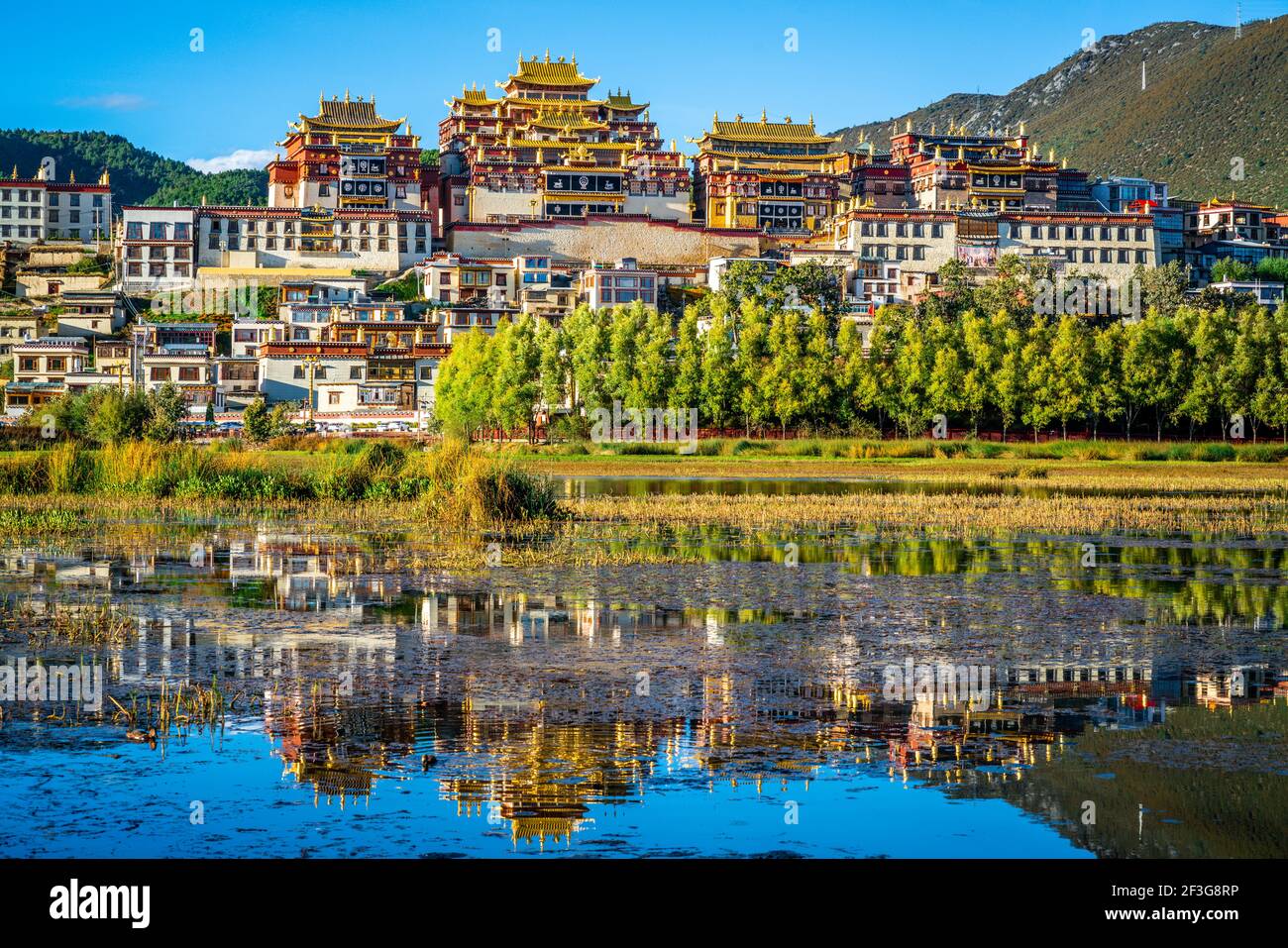
Ganden Monastery.
Main Highlights: What You Absolutely Can’t Miss
Nestled atop Wangbori Mountain, Ganden Monastery, or Ganden Namgyal Ling, is a jewel of Tibetan Buddhism that travelers simply cannot miss. As one of the Great Three Monasteries of the Gelug School, it offers a rich tapestry of history, breathtaking architecture, and spiritual significance. Here’s a guide to the main highlights that will enhance your visit to this iconic site.
1. Immerse Yourself in History
Founded in 1409 by Je Tsongkhapa, the revered teacher and founder of the Gelug School, Ganden Monastery is steeped in history. Tsongkhapa spent much of his time here, meditating in the hermitage below the monastery, and it is where he passed away in 1419. As you walk through the monastery, the echoes of his teachings resonate, making it essential to understand his legacy and the monastery’s role in Tibetan culture. Be sure to visit the Serdung, where Tsongkhapa’s original tomb is located, to pay your respects.
2. Marvel at Unique Architecture
The architectural splendor of Ganden Monastery is a feast for the eyes. The main assembly hall, with its striking white walls and gilded roofs, is a sight to behold. Inside, you’ll find chapels adorned with life-sized statues of the Buddha and murals depicting Tsongkhapa’s teachings. Don’t miss the ochre and maroon chapel housing the gilded statue of Sakyamuni Buddha. Each structure is a piece of art, reflecting the intricate craftsmanship that has survived despite the monastery’s tumultuous history.
3. Experience the Ganden Kora
The Ganden Kora is not just a trek; it’s a pilgrimage that offers stunning views of the surrounding valleys and mountains. This scenic circular route can be completed in a day and is ideal for travelers looking to soak in the beauty of Tibet’s landscape. As you walk, take a moment to appreciate the serene atmosphere and the spiritual significance of this path, often frequented by practicing Buddhists.
4. Attend the Ganden Thangka Festival
If your visit coincides with the Ganden Thangka Festival, you are in for a treat. Held annually on the 15th day of the sixth lunar month, this vibrant event commemorates Je Tsongkhapa’s life. Witness the breathtaking unveiling of a massive thangka, a sacred tapestry that draws thousands of devotees and tourists alike. The sight of this 200-foot tall thangka unfurling against the backdrop of the mountains is a mesmerizing experience, filled with chanting and prayers.
5. Venture on the Ganden to Samye Trek
For those seeking a bit more adventure, the Ganden to Samye Trek presents an exhilarating challenge. Spanning 80 kilometers over 4-5 days, this trek leads you through some of Tibet’s most pristine landscapes, crossing high passes and offering breathtaking views. As you traverse this route, you will encounter traditional Tibetan nomads and stunning natural beauty, culminating at the historic Samye Monastery, the first Buddhist gompa in Tibet.
6. Capture the Moment
Don’t forget your camera! Ganden Monastery offers countless opportunities for stunning photographs, from the intricate details of the chapels to the panoramic views from the kora. The juxtaposition of the monastery against the dramatic Tibetan landscape creates a perfect backdrop for memorable travel photos.
7. Prepare for Altitude
As Ganden Monastery sits at an elevation of around 4,300 meters, it’s crucial to acclimatize properly. Spend a few days in Lhasa to adjust before undertaking any strenuous activities. Staying hydrated and eating nutritious meals will help prevent altitude sickness, ensuring that you can fully enjoy your spiritual journey.
Ganden Monastery is more than just a destination; it’s an experience that connects you with Tibetan culture, spirituality, and history. Whether you’re wandering through its sacred halls, trekking the stunning landscapes, or participating in local festivals, Ganden promises an unforgettable adventure.
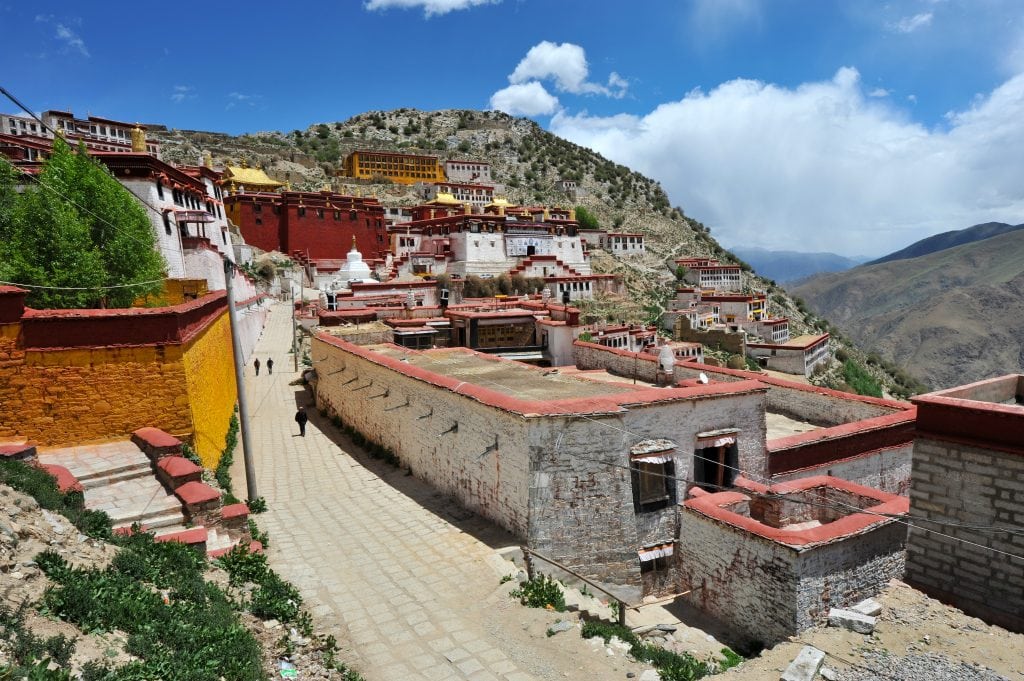
Ganden Monastery.
Planning Your Visit: A Practical Guide
Visiting Ganden Monastery is a unique experience that offers insight into Tibetan Buddhism, stunning landscapes, and a deep connection to the spiritual history of the region. Here’s everything you need to know to make the most of your visit.
Getting There
Ganden Monastery is located approximately 57 kilometers east of Lhasa, making it an ideal day trip. The journey typically involves a drive along the G318 National Road, also known as the Sichuan-Tibet Highway. Travelers will benefit from being accompanied by a guide and driver, as the route winds through beautiful landscapes and winding roads up to the monastery.
Best Time to Visit
While Ganden Monastery can be visited year-round, the ideal time is during the warmer months, from April to October, when the weather is milder and the landscapes are at their most vibrant. If you want to experience the local culture, consider planning your visit during the Ganden Thangka Festival, which occurs on the 15th day of the sixth lunar month. This event features a spectacular unveiling of a massive thangka, attracting thousands of devotees and tourists alike.
Acclimatization and Health
Ganden Monastery sits at an elevation of about 4,300 meters (14,108 feet), which is significantly higher than Lhasa. Prior to your visit, spend a few days acclimatizing in Lhasa to help mitigate the effects of altitude sickness. Here are some tips to prepare:
- Stay Hydrated: Drink plenty of water and avoid excessive caffeine and alcohol.
- Eat Well: Focus on high-protein meals to keep your energy levels up.
- Rest: Allow your body to adjust and avoid strenuous activities until you feel acclimatized.
Exploring the Monastery
Upon arrival, take time to explore the unique architecture and serene atmosphere of Ganden Monastery. Key highlights include:
- Main Assembly Hall: A large white building adorned with gilded roofs and beautiful chapels housing stunning Buddha statues and images of Je Tsongkhapa.
- Ganden Kora: A scenic pilgrimage route that offers breathtaking views of the surrounding mountains and valleys. This circular trek is a highlight for many visitors, making it a must-do activity while at the monastery.
Cultural Insights
Engage with the local culture by observing the daily rituals of the monks and participating in prayer sessions if possible. The monastery is an important center for the Gelug School of Tibetan Buddhism, and witnessing its spiritual practices can be a profound experience.
Trekking Opportunities
For those seeking adventure, consider embarking on the Ganden to Samye Trek. This 80-kilometer trek typically takes four to five days and offers an immersive experience in Tibet’s stunning landscapes, including high mountain passes and lush valleys.
Practical Tips
- Dress Appropriately: Wear layers to accommodate the changing temperatures of the high-altitude environment. Comfortable walking shoes are essential for the kora and exploration.
- Respect Local Customs: Always be mindful of local customs and etiquette, especially in sacred spaces. Dress modestly and speak quietly.
- Take Your Time: Allow yourself ample time to explore and absorb the tranquility of the monastery and its surroundings.
Conclusion
Ganden Monastery is more than just a spiritual site; it’s a gateway to understanding Tibetan culture and history. Whether you’re drawn by the allure of its architecture, the thrill of trekking, or the depth of its spiritual practices, your visit is sure to be a memorable highlight of your journey through Tibet. Prepare well, respect the local culture, and embrace the breathtaking beauty that surrounds this iconic monastery.
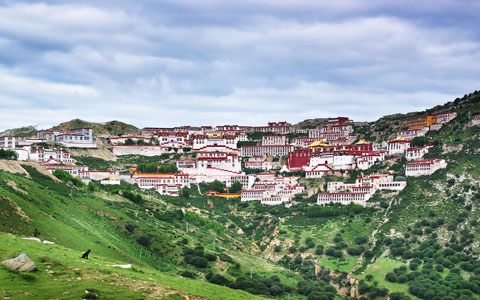
Ganden Monastery.
Tickets: Prices, Booking, and Tips
When planning your visit to Ganden Monastery, it’s essential to consider the ticketing process, pricing, and a few handy tips to make the most of your experience.
Ticket Information and Prices
Admission to Ganden Monastery is quite affordable, making it accessible for international travelers. As of 2023, the entrance fee is approximately 30 RMB (about 5 USD). This fee grants you access to the monastery’s main areas, including its stunning chapels and assembly halls, where you can immerse yourself in the rich history and spiritual ambiance of this sacred site.
Booking Tips
-
Guided Tours: While it’s possible to visit Ganden Monastery independently, joining a guided tour is highly recommended, especially for international travelers. Local guides can provide invaluable insights into the monastery’s history, architecture, and cultural significance. Many tour companies offer packages that include transportation from Lhasa, which can enhance your experience.
-
Book in Advance: If you’re planning to visit during peak travel seasons or special events, such as the Ganden Thangka Festival, it’s wise to book your tour in advance. This ensures you secure a spot and can often lead to better prices and availability.
-
Check for Discounts: Some tour companies may offer early-bird discounts or special rates for groups. Always inquire about any potential savings when booking your trip.
Additional Tips
-
Plan Your Visit: Ganden Monastery is located about 57 kilometers east of Lhasa. Allocate a full day for your visit to allow time for exploration and a leisurely trek along the Ganden Kora, which offers breathtaking views of the surrounding landscape.
-
Acclimatization: Given the altitude of around 4,300 meters (14,100 feet), it’s crucial to acclimatize in Lhasa before your visit to avoid altitude sickness. Spend a few days in the city, stay hydrated, and avoid strenuous activities until you feel comfortable.
-
Respect Local Customs: As a place of worship, it’s important to dress modestly and behave respectfully during your visit. Be mindful of the local customs, and consider participating in or observing the daily rituals and practices of the monks.
By keeping these details in mind, you’ll be well-prepared for an enriching visit to Ganden Monastery, where history, spirituality, and stunning natural beauty converge. Enjoy your journey into the heart of Tibetan Buddhism!
How to Get There: A Complete Transportation Guide
Getting to Ganden Monastery is a journey filled with stunning landscapes and rich cultural experiences. Located approximately 57 kilometers east of Lhasa, it is easily accessible by road, making it a popular day trip or a part of a longer itinerary in Tibet. Here’s how you can reach this iconic site.
By Private Vehicle
The most convenient way to reach Ganden Monastery is through a guided tour that includes private transportation. Many tour companies in Lhasa offer packages that cover this journey. Your guide and driver will take you along the scenic route that leads to the monastery.
Route Overview:
1. Departure from Lhasa: Your journey begins in Lhasa, where you will be picked up from your hotel.
2. Cross the Lhasa River: The initial part of the drive takes you across the Lhasa River.
3. Join the G318 National Road: After about 30 kilometers, you will connect with the G318 National Road, also known as the Sichuan-Tibet Highway, which offers breathtaking views of the Tibetan landscape.
4. Turn Off the Highway: A few kilometers later, you’ll take a turn that leads you towards the foothills of Wangbori Mountain.
5. Winding Roads to the Monastery: The final stretch includes winding roads with hairpin bends, taking you up the mountain to the monastery.
By Public Transport
If you’re looking for a more budget-friendly option, public transport is available, although it requires a bit more effort and time.
- Bus Services: You can catch a bus from Lhasa to the nearby town of Dagzê County, which lies close to Ganden Monastery. From Dagzê, it’s advisable to hire a local taxi or arrange for a private vehicle to take you to the monastery’s entrance.
- Frequency: Buses may not run as frequently as you’d like, so check the current schedules in advance.
Trekking to Ganden
For the adventurous traveler, trekking to Ganden Monastery can be an exhilarating experience. The Ganden Kora is a popular pilgrimage route that allows you to immerse yourself in the stunning natural beauty of the region while exploring the cultural significance of the site.
- Kora Route: The trek can be completed in a day and varies in difficulty, making it accessible for most travelers who are acclimatized to the altitude.
- Scenic Views: As you trek, you will be treated to panoramic views of the valleys and mountains surrounding Ganden, enhancing your spiritual journey.
Considerations
- Altitude: Ganden Monastery sits at an elevation of approximately 4,300 meters (14,107 feet). Ensure you are acclimatized to Lhasa’s altitude (around 3,650 meters) before embarking on your journey to avoid altitude sickness.
- Travel Time: The drive from Lhasa to Ganden typically takes about 1.5 to 2 hours, depending on road conditions and traffic. If you choose to trek, allow a full day to complete the kora route.
- Best Time to Visit: While Ganden can be visited year-round, the best time is during the spring and autumn months when the weather is mild and the scenery is particularly beautiful. The Ganden Thangka Festival, held annually on the 15th day of the sixth lunar month, is also a vibrant time to visit.
Whether you choose to travel by private vehicle, public transport, or on foot, the journey to Ganden Monastery promises to be an unforgettable experience filled with breathtaking views and rich cultural heritage.

Ganden Monastery.
Local Cuisine and Accommodation Nearby
When visiting the stunning Ganden Monastery, an essential part of your journey is indulging in the local cuisine and finding comfortable accommodation nearby. This area, steeped in Tibetan culture, offers a variety of options that complement the serene experience of the monastery.
Local Cuisine
Tibetan food is known for its hearty and nourishing qualities, perfect for travelers exploring the high altitudes. Here are a few local delicacies you shouldn’t miss:
-
Momos: These Tibetan dumplings are a must-try. Typically filled with meat (such as yak or chicken) or vegetables, momos are steamed or fried and served with a spicy dipping sauce.
-
Thukpa: A flavorful noodle soup, thukpa is a popular dish among locals and visitors alike. You can find various versions, including meat and vegetarian options, making it a delightful warming meal after a day of trekking.
-
Tsampa: This traditional Tibetan dish is made from roasted barley flour mixed with water or tea to form a dough-like consistency. It’s a staple food that provides energy for the high-altitude lifestyle, often enjoyed with butter or jam.
-
Butter Tea (Po Cha): A unique beverage made from tea, butter, and salt, this drink is especially beloved in Tibet. It’s rich and creamy, perfect for sipping while taking in the spectacular views around the monastery.
-
Dried Yak Meat: For adventurous eaters, trying dried yak meat is an experience in itself. This traditional snack is both nutritious and packed with flavor, often enjoyed with a side of local cheese.
Accommodation Nearby
After a fulfilling day exploring Ganden Monastery, a good night’s rest is essential. Here are a couple of accommodation options nearby that cater to various budgets and preferences:
-
Ganden Hotel: Located just a short drive from the monastery, this hotel offers comfortable rooms with stunning views of the surrounding mountains. The on-site restaurant serves authentic Tibetan cuisine, making it convenient for guests to enjoy local flavors without having to travel far.
-
Ganden Guesthouse: A cozy, family-run guesthouse providing a warm and welcoming atmosphere. With simple yet comfortable rooms and a communal dining area, it’s a great place to meet fellow travelers. The hosts are known for their hospitality and can help arrange guided tours or suggest nearby hikes.
-
Tibetan Homestays: For a more immersive experience, consider staying with a local family in a homestay. This option not only gives you a taste of genuine Tibetan hospitality but also the chance to learn about local customs and traditions directly from your hosts.
-
Lhasa Hotels: If you prefer to stay in Lhasa, several hotels offer day trips to Ganden Monastery. Options like the Brahmaputra Grand Hotel and Yarlung Zangbo Hotel provide comfortable accommodations and are well-rated for their service and amenities.
Whether you’re savoring traditional dishes or unwinding in cozy lodgings, the area surrounding Ganden Monastery offers a delightful taste of Tibetan culture that will enhance your travel experience. Don’t forget to take in the breathtaking views and the serene atmosphere as you explore this remarkable region!
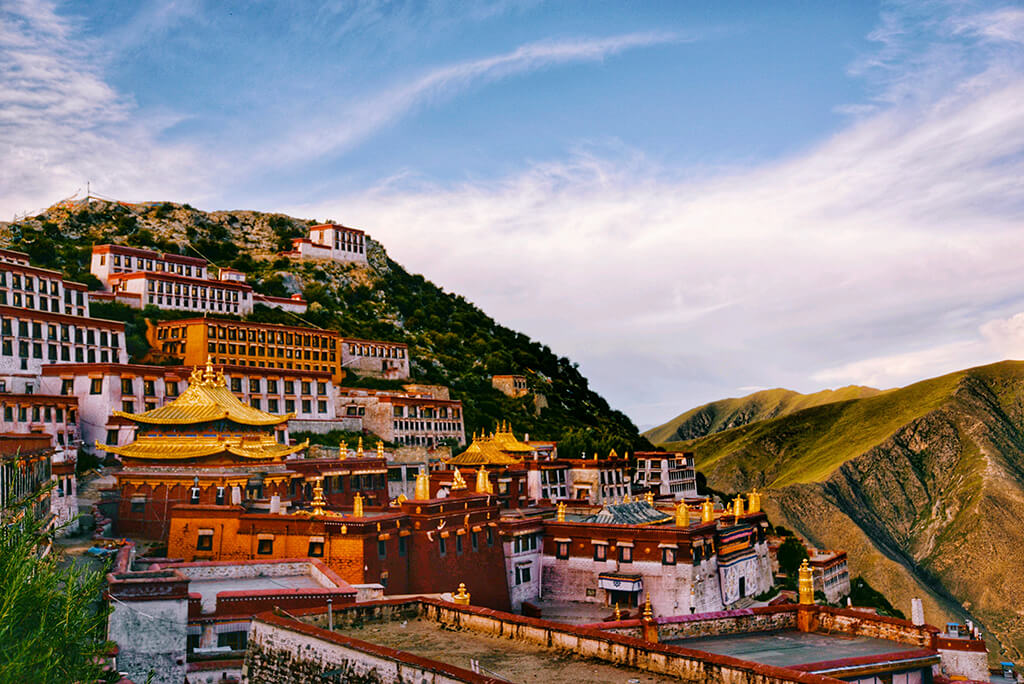
Ganden Monastery.
Frequently Asked Questions
-
What is the best time to visit Ganden Monastery?
The best time to visit Ganden Monastery is during the spring and autumn months (April to June and September to November) when the weather is mild and the views are breathtaking. If you’re interested in cultural experiences, consider timing your visit to coincide with the Ganden Thangka Festival, held on the 15th day of the sixth lunar month, when a massive thangka is unveiled. -
How do I get to Ganden Monastery from Lhasa?
Ganden Monastery is approximately 57 kilometers east of Lhasa. Most visitors take a guided tour, which includes transportation. The journey takes you along the scenic G318 National Road, leading you through stunning landscapes before winding up to the monastery. -
What should I wear while visiting Ganden Monastery?
Dress in layers as temperatures can vary greatly throughout the day. Comfortable, warm clothing is essential, especially since Ganden is situated at a high altitude. Sturdy shoes are also recommended for exploring the kora paths around the monastery. -
What altitude should I expect at Ganden Monastery?
Ganden Monastery is located at approximately 4,300 meters (14,107 feet) above sea level. It’s crucial to acclimatize in Lhasa for a few days before visiting to avoid altitude sickness. Stay hydrated, eat well, and rest as needed. -
Are there any restrictions on photography at the monastery?
Photography is generally allowed in most areas of Ganden Monastery, but it’s important to be respectful of the monks and the sacred spaces. Avoid taking photos during ceremonies or in places where it’s explicitly prohibited. -
Can I hike the kora around Ganden Monastery?
Yes! The Ganden Kora is a beautiful and spiritually significant trek that can be completed in a day. It offers stunning views and is a popular pilgrimage route. Make sure to acclimatize first, as it is a higher elevation than Lhasa. -
What facilities are available at Ganden Monastery?
While Ganden Monastery is primarily a religious site, there are basic facilities available such as restrooms and areas to sit and enjoy the views. It’s advisable to bring snacks and water with you, as options may be limited. -
Is it possible to stay overnight at Ganden Monastery?
Overnight stays are not typically offered at Ganden Monastery itself. However, you can find accommodations in nearby settlements or return to Lhasa for the night. Some guided tours may include overnight options in the vicinity for a more immersive experience.
Final Thoughts on Your Trip
As you prepare to leave the serene embrace of Ganden Monastery, take a moment to reflect on the profound experiences and breathtaking landscapes that have surrounded you. This sacred site, rich in history and spirituality, offers more than just a glimpse into Tibetan Buddhism; it invites you to connect with the essence of a culture that has thrived for centuries.
Whether you’ve walked the revered kora trails, marveled at the intricate architecture, or perhaps witnessed the mesmerizing Thangka Festival, each moment spent here adds a layer to your understanding of Tibet’s rich tapestry. The stunning vistas of the Wangbori Mountain and the peaceful chants of monks will linger in your memory long after your visit.
Embrace the spirit of Ganden as you continue your journey through Tibet. Each step you take from this extraordinary monastery is a step deeper into a land steeped in tradition and breathtaking beauty. Remember, the echoes of your time here will resonate within you, inspiring your travels and reflections for years to come. Safe travels, and may your adventures continue to be as enriching and enlightening as your visit to Ganden Monastery.